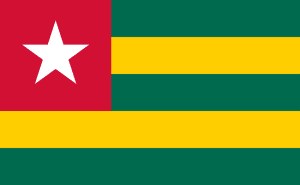
| Colors | HEX Code | RGB | CMYK |
|---|---|---|---|
| Green | #01694D | 1, 105, 77 | 99, 0, 27, 59 |
| Yellow | #FFCE00 | 255, 206, 0 | 0, 19, 100, 0 |
| Red | #D21034 | 210, 16, 52 | 0, 92, 75, 18 |
| White | #FFFFFF | 255, 255, 255 | 0, 0, 0, 0 |
The flag of Togo has five equal horizontal stripes of green color alternating with yellow, and a red square with a white, five-pointed star in the upper hoist side.
Meaning of the flag of Togo
The flag of Togo is inspired by the Pan-African colors. The five stripes represent the five administrative regions of the country. The green color represents agriculture and hope. The yellow color symbolizes faith in work for development and the country’s resources. The red color signifies charity, fidelity, and love, and the blood that was shed for the sake of the country. The white color is for peace. The star represents hope and unity.
History of the Flag of Togo
Togo was a German protectorate before France and Britain took control of the region in 1914. Togoland was divided into two regions. The British Togoland and the French Togoland raised two different flags. The British Togoland flag was the Blue British Ensign with the emblem of the country. The French Togoland hoisted the French tricolor, then it became an autonomous nation in 1958, and a new flag with a green field and two five-pointed stars was adopted. The canton of the flag featured the French tricolor. In 1960 Togo gained full independence from France and Britain and adopted a new flag with the green and yellow stripes, red square and white star. The new flag was designed by Paul Ahyi, a famous African artist, and was officially hoisted on April 28, 1960.